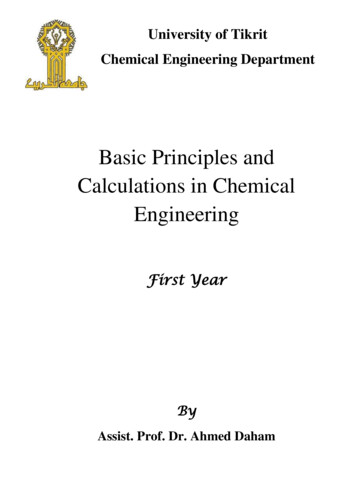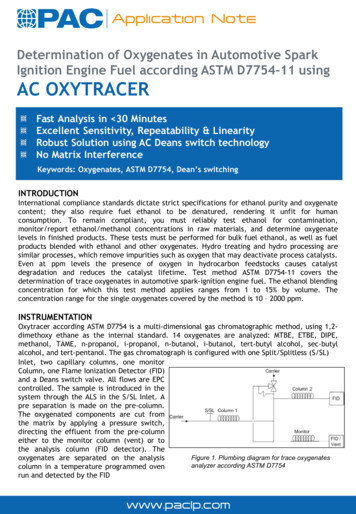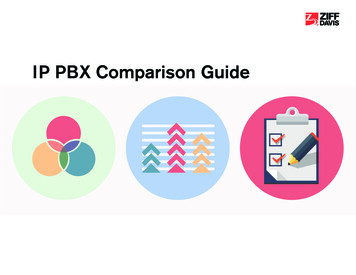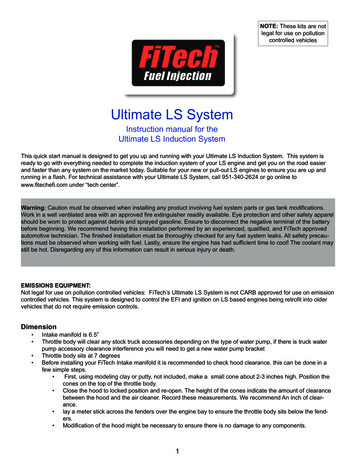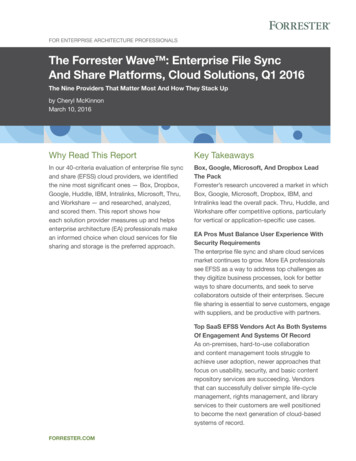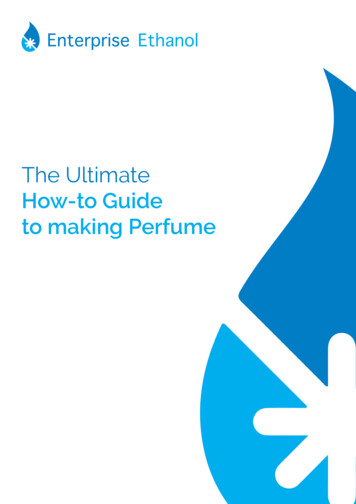
Transcription
The UltimateHow-to Guideto making Perfume
Table of Contents3Introduction4The History of PerfumeWho is the Guide designed for?The progress of perfume through ancient times to modern-day practices6The Basics of Fine FragranceBasic Information around Perfume and fragrances9How Perfume is MadeFrom ingredients to maturation, these steps highlight the process of perfumery12Perfume as a Business13The Fragrasol Formula14Supplier ListThe economic viability of starting your own perfume businessHow to create your own perfume in 3 easy stepsA comprehensive list of all suppliers to get you started!19Resources and ReferencesLearn how to makeyour own perfume in3 STEPS - page 13
IntroductionFrom the Ancient Egyptians to the tales told from religions, humanshave always wanted to enhance their scent, emulating the smells ofnature. Not only does Perfume, or “fragrance of the gods,” have anintimate history with mankind, but it is also a global market that isprojected to reach US 92 billion by the year 2024.Who is this How-To Guide designed for?This comprehensive eBook is designed to suit anyone looking for detailed information onhow to create perfume, or more facts and insights into the perfumer’s world. Packed withrelevant business information and helpful how-to’s, this guide will assist anyone wanting to:1.2.3.4.5.6.Start a Perfume BusinessLearn how Perfume is madeLearn how to formulate your own fragrances and scentsLearn what ingredients perfumes are crafted fromLearn how to create a homemade perfumeLearn about the history of perfumeAnyone with the slightest interest in fragrances or perfumery can create a signature scent.Not only will you learn how to master the art of creating perfume, but the lessons learntcan be applied to a range of scented crafts; including room diffusers, cosmetics, andadvanced perfumery.This fascinating craft will push you to explore new senses and sensations, and thesatisfaction of blending your ideas to perfume perfection makes this a rewarding interest!Read on to discover!3
HistoryPerfume began with the ancient Egyptians, where itinfluenced the Romans, then the Greeks, and onwardsto the Oriental kingdoms. It was only when 13th centuryCrusaders bought back samples to Italy, Franceand England that new and innovative methods andingredients would lead to our contemporary perfumes.The below timeline gives interesting insights into theprogress of perfume, which was crafted out of periodsof strife and innovation in his Natural History, that we canrecreate these scents in our modern times.Archaeological teams unearthed an enormous factorythat existed 4 000 years ago during the Bronze Age.How did Perfume become a modern icon?1200 BCE MesopotamiaA woman named Tapputi was the first recorded chemist, with her existence found ona 1200 BC Cuneiform tablet in Babylonian times. She was a powerful member withinthe Mesopotamian government and religion as overseer of the Royal palace. Shedeveloped methods for oil and scent extraction as the basis for perfume crafting,with her ground-breaking techniques in solvents pushing the craft forward.Ancient EgyptThe Ancient Egyptian wealthy families begin wearing and enthusiastically adoptingperfumes, using the scents for religious and beautification purposes. Fragranceswere thought to be the sweat of the Sun-God, Ra. Nefertum, the God of Fragrance,even wore a head dress made of water lilies, an iconic perfume ingredient of thetime. The Ancient Egyptians also had complex recipes, formulas and apparatusfor perfumery, and imported vast amounts of ingredients from Punt, in Africa,indicating international trade relations at play.4
Ancient RomeThe oldest perfumery factory, and the mythical home to the Goddess of Love,Aphrodite, was discovered in Cyprus in 2007. Archaeological teams unearthed anenormous factory that existed 4 000 years ago during the Bronze Age. It was over4,000m², indicating perfume making on an industrial scale for the temples and thepeople. It is estimated that by 100 AD, Ancient Romans were using 2 800 tons offrankincense a year! There are so many perfume recipes from the ancient Romansand Greeks, carefully penned by people like Pliny the Elder in his Natural History,that we can recreate these scents in our modern times.Ancient PersiaThe Ancient Persians were huge stakeholders in perfume and dominated the tradefor hundreds of years. The Persian Muslim doctor and chemist Avicenna (also knownas Ibn Sina) is thought to have introduced the process of extracting oils from flowersby means of distillation, the procedure most commonly used today, and was first tofigure out the chemistry behind perfumes that weren’t oil-based.Medieval EuropeAfter the Holy Wars in Arabia, and the already blossoming perfume industries ofother lands, Crusaders bought the concept of perfume with them on their return. Thewealthy of the time carried Pomanders, a ball of scented material kept in a beautifulopen case that was meant to ward off infections and ‘bad air.’ Here, the first alcoholbased perfume was created. Known as Hungary Water, as it is believed to have beencrafted for the Queen Elizabeth of Hungary in 1370, using distilled alcohol and herbs.1400-1500s ItalyMedieval Italy was the home to the modern-day liquid perfume. After thebreakthrough discovery of aqua mirabilis, which was a clear substance made of 95percent alcohol and imbued with strong scent. Eureka- modern day perfume! Afterthis, Venice became the centre of the world trade in perfume for hundreds of years.However, it is Catherine de Medici, an Italian bride wed to the French king, who iscredited with bringing perfume to France, England and the rest of the world.1800’s to Modern DayBy the late 1800’s, synthetic compounds were being discovered, and themodern perfume industry was born.5
The Basics of Fine FragranceFragrance and Perfume Basic InformationPerfume is a product of the extracted oils of plants andflowers with a base solvent, such as alcohol. Lovedfrom as early as 3 000 BCE, the captivating scents ofnature evoke emotions and memories that our othersenses can’t grasp. Our emotional ties to the smells thatsurround us often make perfume ‘liquid memories.’Perfume ClassificationsThere are 3 basic categories into which perfumes are classified:1.2.3.The concentration or dilution level of theessential oils to alcohol solventThe scent family to which it belongsThe notes of the scentPerfume ConcentrationsWhat is the difference between Perfume, Eau de Parfum,Eau de Toilette and Eau de Cologne?The different names for the types of perfume refer to theconcentration of perfume oil to alcohol. Perfume oils are extremelyintense, toxic and concentrated, so it needs to be distilled usingalcohol as the base.Fragrances need 3notes to keep theperfume well-roundedand long-lastingEau de CologneEau de ToilettePerfume, Parfum or ExtraitEau de ParfumBetween 2-5% PerfumeBetween 4-10% Perfume15-25% Perfume oil hasBetween 8-15% Perfumeoil in alcohol and water,oil in alcohol, this is a lightthe highest fragranceoil, this is a commonthis concentration is thespray composition andconcentration and is thefragrance type andmost diluted and lastlasts for about 3 hours.most expensive. Not alwayssuitable for everyday wear,suitable for dry or sensitivelasting up to 8 hoursfor 2 hoursskin, but usually lasts8-24 hours6
The Fragrance FamilyHow to understand where a scent sitsThere are numerous categories within the fragrance wheels, as well as different models of the FragranceWheel. We choose to follow the Michael Edwards Fragrance Wheel, a consultant in the perfumeindustry and known as the finest ‘nose’ in the world.A Fragrance Wheel is meant to assist users in understanding the notes and styles that they desire,although often a favourite scent is a combination of a few notes and sections! The Fragrance Wheelbreaks down the perfumes into several main categories, and then similar styles and subcategorieswithin each.FLORAL NOTESORIENTAL NOTESWOODY NOTESFloral: Fresh cut flowersSoft Floral: Aldehydes &powdery notesFloral Oriental: OrangeBlossom & sweet spicesSoft Oriental: Incense &amberOriental: Oriental resinsWoody Oriental:Sandalwood & PatchouliWood: Aromatic woods& VetiverMossy Woods: Oakmoss& AmberDry Woods: Dry Woodsand LeatherFRESH NOTESFOUGÈRE NOTESAromatic: AromaticHerbs & LavenderCitrus: Citrus Oils &BergamotWater: Marine & AquaticNotesGreen: Green notes &GalbanumFruity: Fruits & BerriesFougere is French for fern and is a combination of elements fromthe above groups, containing the largest variety of scents since itmade up of combinations of elements from the other groups.7
Scent Notes The Fragrance PyramidWhat are the base, heart and floral notes of perfume?ApplicationHighTopNotes15 minutesVolatilityThe mark of a good perfume is one thattells its story over time. A perfume is meantto unfold as the hours progress, providingnew smells and notes to carry. Perfumes areformulated using 3 notes as the base- Topnotes, Middle Notes and Base notes. Each ofthese represent a different category of scentswithin the perfume’s unique recipe, and thesenotes interchange over time.MiddleNotes30 minutesBaseNotesLowTopNotesMiddleNotesBaseNotes5 hoursThese are the first impressions of a perfume. Strong, intense and bold, they introducethe fragrance. Made of lighter molecules, these generally last between 10 and 30minutes before evaporation, allowing the middle notes to come to the forefront.Examples of Top Note Scents: Citrus such as Bergamot and lime, Eucalyptus, SageOften known as the heart notes, these are noticed as the top notes disappear, roughly10 minutes to 45 minutes. These are giving scents, lasting up to 6 hours.Examples of Middle Note Scents: Scents: Pine, Lavender, Pepper and GeraniumThe lingering foundation of every perfume, the base notes of perfume comprise theheaviest and largest molecules that take time to evaporate, even lasting beyond 24hours.Examples of Base Note Scents: Sandalwood, Patchouli, Clove, Vanilla, RoseImportant to note that it is the middle and base notes of a fragrance that build thefoundation and roundedness of any perfume.Create your own Perfume today!Visit Page 13 to find out how!8
How Perfume is MadeHow to Make PerfumeGumsThe IngredientsNatural Ingredients of PerfumeHistorically, perfumes were dominantly manufactured fromnatural resources, such as woods, grasses, gums, resins, fruits,spices and flowers. Flowers are especially important as it isvery difficult to create a perfume without a floral heart andfloral essences, but not all flowers produce the oils neededfor scent. The Lily of the Valley, although heady in floweringaroma, is such a plant. It is estimated that roughly 2,000 of the250 000 known flowering plant species contain the essentialoils needed for perfumes. Perfumes can also be made withanimal products, such as musk from male deer in Tibet, castorfrom beavers in Canada, and ambergris from Sperm whales,which has been outlawed since 1977.GrassWoodFruitSpicesFlowersResinsIt is estimated that only 2,000 of the 250 000 known floweringplant species contain the essential oils needed for perfumesThe process of manufacturing natural sources is exorbitant- a 15-mililiter bottle of French perfume needsthe extracted oil from 660 roses, and Sandalwood and Rosewood demands have led to deforestationaround the world. Potential crop fails, animal suffering and conservation concerns have all drivenperfumers to start using synthetic ingredients.Synthetic Ingredients of PerfumeSynthetic ingredients are aromatic chemicals that replicate naturalsources and ingredients. It is estimated that synthetic compoundscontribute to two-thirds of all the most popular fragrances madetoday. Lab manufactured; synthetic ingredients have the additionalbenefits of a longer-lasting and denser scent through syntheticfixatives, the ability to blend with essential oils (allowing forcountless variations), and the conservation of the planet.A 15ml bottle ofFrench perfumeneeds theextracted oilfrom 660 rosesThere are 3 main types of Synthetic ingredients for perfume:1. Full Synthetics: These synthetics are almost entirely manufactured from petroleum by-products2. Semi-Synthetics: Natural scents that have been modified by artificial means3. Natural Isolates: Fragrances that sit between natural and synthetic as they have been developedby isolating one smell from a more complex base9
Perfume Ingredient CollectionWhether large-scale or small business, it’s imperative that you have the source of your scents priorto beginning. Plant fields must be harvested, often handpicked by quality of fragrance. Animal byproducts are extracted from the fatty substances and glands directly from the animal. Aromaticchemicals, if using synthetic compounds, must be created in the laboratory by perfume chemists,which we recommend. Perfume Extraction MethodsBelow are the 5 main methods of Perfume Extraction, whereby the oils are extracted from plant andnatural matter.Steam DistillationThis process of perfume extraction involves pushing steam through plantmaterial, where the essential oils turns to a gas. This gas is processed throughtubes, cooled and liquified. Some oils can be extracted by boiling parts of theplant, such as the petals.Solvent ExtractionSome manufacturers choose to extract using solvents. Plant partsare dissolved in benzene, which leaves a waxy material whichcontains the oils. The wax is then exposed to ethyl alcohol. Duringthis method, plant parts are dissolved in benzene and exposed toethyl alcohol, which is then burned off, leaving a higher concentration of the perfume oil on the bottom.EnfleurageIn this process of perfume extraction, flowers are placed on glass sheetswhich are coated in grease. Stacked in wooden tiers, the flowers areremoved by hand and changed out until the grease has absorbed the flowerfragrance.MacerationLike enfleurage, maceration is a process of perfume extraction that uses warmed fats toabsorb a flower’s fragrance. Just like solvent extraction, the fats and grease are burnt offin alcohol, leaving the essential oils behind.Blending Your Perfume OilsThe process of blending is normally done by a master in the perfumer’s field,commonly known as a ‘nose.’ The master perfumer has a specific formulaor recipe that often takes thousands of attempts to perfect. It could take asmany as hundreds of different ingredients and notes to develop the formula,and years to develop to a fine fragrance.10
Once the scent has been created, it is mixed with alcohol. The alcohol base that is used is critical to theoverall quality and longevity of the perfume, so an Ethyl alcohol with the least impurities is ideal. Werecommend using the purest ethanol available – make sure to check and compare the certificate ofanalysis for impurities.The amount of alcohol to perfumer’s oil differs greatly, and fragrances are given different names dependingon their concentration. Below is a guide to the naming protocol associated with perfume sprays:Eau de Cologne Between 2-5% Perfume oil in alcohol and waterThe oldest term for perfume, this concentration is the most dilutedLasts for about 2 hoursUsually sold in sprays, Eau de Cologne is normally marketed to the youth marketsEau de Toilette Between 4-10% Perfume oil in alcoholA light spray composition with 4% – 10% pure perfume essence dissolved in alcohol.Usually lasts for about 3 hours.Eau de Parfum Between 8-15% Perfume oilOne of the most common fragrance types and is suitable for everyday wearContains 15% – 20% pure perfume essenceLasts for about 5 to 8 hoursPerfume, Parfum or Extrait 15-25% Perfume oilParfum, also known as extrait de parfum or pure perfume, has the highest fragranceconcentration.Lasts the longest of all, usually 8-24 hoursNot always suitable for users with dry or sensitive skinThe most expensive of all scentsSlightly thicker and oilierPerfume Ageing and MaturationOnce you have gathered, extracted, blended and mixed with alcohol, your perfuming concoction needsto settle and mature. In this stage the perfume is set aside in a dark, cool space where it stays anywherefrom 30 days to one year, without any disturbances.The ageing process allows the alcohol and oils to bind together, resulting in a collected scent. Fromhere, the perfumer will test the smell and make sure the fragrance has the notes that they’re looking for.Adjustments, tweaks, and additional blending can take place here, perfecting the perfume. After anychanges, allow the perfume to sit for a few more weeks to mature.11
Perfume as a BusinessThe economic viability of starting your own Perfume BusinessPerfuming can be quite complex, especially if reliant on natural sources, such as plant and animal oils.Harvesting of huge fields, handpicking, collecting, extracting, blending and maturation can take a vastamount of time, resulting in the industry only being viable to a few brands.Modern perfumery has allowed for more new and diverse methods of manufacturing than in previouscenturies. Today, anyone can craft a signature scent using synthetic compounds instead of natural oils.Another trend is the market’s desire for less concentrated forms of perfume that are less drying andmore for everyday uses. The combined factors of lab created ingredients and lower concentrationsof pure perfume have resulted in the decreased costs of scents, encouraging more widespread andfrequent use by consumers, and allowing new business opportunities for those interested.120Market size in billion U.S. .685.188.578.640200The economic viability of the perfume industry is expected togrow at rapid rates in the coming years. Worth 60.6 billion in2012, the industry is expected to grow to an estimated globalmarket of 92 billion by 2024.Of the total fragrance industry market share, household and personal care contributed the most tomarket share. And as developing countries such as India, China and Africa acquire more disposableincome, the desire for luxury goods such as fragrances and perfume becomes more necessary.Starting a profitable perfume business is within anyone’s grasp, and thanks to modern-day innovations,is relatively easy to create. Using the Fragrasol Formula, a tried and tested method, this easy threestep process gives new perfumers a stable and simple way of crafting desirable perfumes.12
The Fragrasol FormulaHow to make Perfume in 3 Simple StepsThe Fragrasol Formula is an internationally recognised formula for creating perfume. Using FragrasolPerfume solvents as the alcohol base, this cosmetic grade, 99.9% pure ethanol is the ultimate perfumer’salcohol. With no impurities, this solvent is manufactured and supplied according to the highest standardsand needs of the perfume industry. Combined with the remaining instructions of the Fragrasol Formula,your perfect perfume scent is only a few steps away!The below guide is based on synthetic ingredients, using the simplest steps to creating perfume.1Step 1 Gather Your MaterialsWhat you’ll need:1. Fragrasol Perfume Solvent Perfumers Alcohol2. Synthetic Scent Solution Perfume Oil or Compound3. Glass Mixing Beaker or Fluoride Plastic bottles4. Measuring Jug or Beaker2Step 2 Measure and Mix1.2.3Now we’re ready to mix our scent and alcohol solvent! Make sure you have measuredout the correct quantities of perfume oils to perfumer’s alcohol. Below is a commonformula that will guide you to the perfect perfume/alcohol ratio.Desired amount of perfumeQuantities500ml Perfume100ml Perfume Oil to 400ml Fragrasol1 litre Perfume200ml Perfume Oil to 800ml Fragrasol2.5 litres Perfume500ml Perfume Oil to 2 litres FragrasolMix your perfume oils with your Fragrasol Perfumer’s Alcohol in a glass beaker orfluoride plastic bottles. Shake vigorously for 30 seconds or more.Step 3 Maturation1.2.3.4.Now that you have the perfume scent and oils mixed, it’s time for the toughest part-waiting.The scented oils and the perfumer’s alcohol need time to bind and mix, so set aside at least30 days for the process of ageing and maturation to occurPack your perfume, still contained in a glass beaker or fluoride bottles, in a dark, cool spacewhere it will not be disturbed at allAfter 30 days, or longer if you can wait, re-test your perfume by smelling it. If it needsadditional notes or tweaks, now is the time to add any new scents.If your perfume smells like you wanted, simply decant into perfume bottles and getting readyto spray or sell!13
Supplier ListWe’ve put together a Supplier list of all suppliers who provide quality perfuming products. Thesesuppliers have a range of products, tools and advice so feel free to get in touch and ask a fewquestions!1.3.4.5.6.Perfumer’s Alcohol SupplierPerfume Synthetic Oils SupplierPerfume Bottles and SprayersFluoride BottlesGlass Beakers and MixersEnterprise EthanolScent labBonpakScent labBonpakCome visit us ca14
Fragrasol Perfumer’s Alcohol Enterprise EthanolFragrasol is Enterprise Ethanol’s in-house range of perfumer’s alcohol. Offering 3 types of Perfumer’salcohol, consumers can be assured that the alcohol solvent to perfumes is 99,9% pure and testedaccordingly.Fragrasol 901 Basic Perfume SolventOur Fragrasol 901 is designed for basic perfumery application. This denatured ethanol product is anover the counter answer to those who do not have a licence to purchase pure ethanol Basic Perfume Solvent FormulaFully Denatured SpiritNo Rebate License RequiredApplications Basic perfumeryFragrance baseRoom diffusersFind out moreFragrasol 955 Standard Perfume SolventOur Fragrasol 955 product caters to the commercial sector, offering a unique fully denatured productthat still maintains a 99.9% alcohol purity, ensuring quality application Standard Perfume Solvent FormulaFully Denatured SpiritNo Rebate License RequiredApplications: Commercial perfumeryFragrance baseFind out more15
Fragrasol 1020 Advanced Perfume SolventOur Fragrasol 1020 product is an advanced formula based on 99.9% pure alcohol. This fully denaturedproduct contains key ingredients that makes it an ideal perfume solvent base Advanced Perfume Solvent FormulaFully Denatured SpiritNo Rebate License RequiredApplications: Advanced commercial perfumeryFragrance baseFind out moreEnterprise Ethanol also offers advice around appropriation, licensing and any perfuming questions youmay have. We are also open to the public, and consumers are welcome to stop by our retail shop to viewthe products.Website: www.enterpriseethanol.co.zaAddress: 8 Avalon Road, Westlake View, ModderfonteinEmail: sales@enterpriseethanol.co.zaFacebook: www.facebook.com/EnterpriseEthanol16
Perfume Packaging BonpakBonpak is South Africa’s leading supplier of glass and plastic containers, with a special focus on perfumebottles. Bonpak’s competitive pricing and flexibility in order quantities, means the smaller bottlers cancompete in any market whilst offering first-time entries and home industries a chance to grow theirbusiness without having to invest in large quantities of containers. The wide range of sizes and shapesfrom both local and imported manufacturers starts with a 5ml dropper bottle to a 4.5Lt (one gallon) jar.Closures are available of all the jars and bottles supplied, offering a one stop shop for customers.Bonpak offer a range of perfuming bottles, containers, lids and corks- below are some of our favourites: Perfume Pen SprayersPerfume bottlesCredit Card SprayersRoll OnGlass VialsHelpful, open to the public- and with no minimum orders, Bonpak offers a full retail store with collectioncapacity, or nationwide delivery.Website: www.bonpak.co.zaAddress: 8 Avalon Road, Westlake View, ModderfonteinEmail: sales@bonpak.co.zaFacebook: www.facebook.com/BonpakSA17
Synthetic Perfume Scents Scent labScent Lab is the leading supplier of fine fragrance oils. Offering more than just quality perfume oil – theyoffer advice, formulations and so much more. Defined by Quality, supported by affordability, Scent lab isthe preferred perfume supplier.Offering pre-packaged scents, inspired by the worlds most iconic fine fragrances, you can expect todiscover scents such as Armani Si, Coty, and Elizabeth Arden Red Door. Alternatively, chat to the teamsto discover how to create your own signature scent!Website: www.scentlab.co.zaAddress: 8 Avalon Road, Westlake View, ModderfonteinEmail: info@scentlab.co.za18
Carefully crafted and produced byQwerty Digital Performance ConsultantsDigital with .zaResources and mwww.fragrancesoftheworld.comwww.perfume.comGet in touch today!087 135 092719
The History of Perfume The progress of perfume through ancient times to modern-day practices The Basics of Fine Fragrance Basic Information around Perfume and fragrances How Perfume is Made From ingredients to maturation, these steps highlight the process of perfumery Perfume as a Business The economic vi
